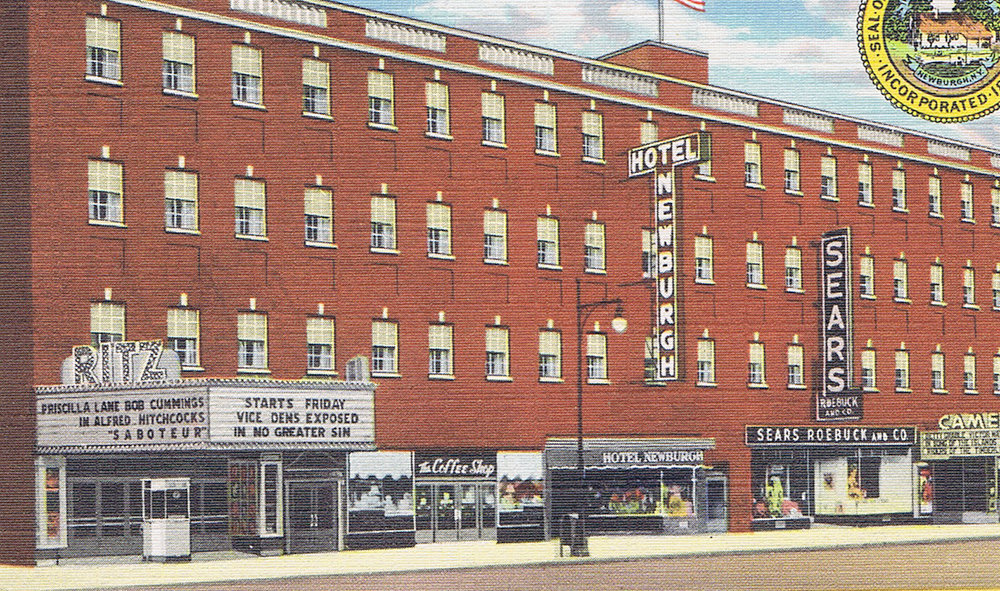
The facade of the Hotel Newburgh in 1942 with Sears Roebuck in a central spot.
By Mary McTamaney
News that the big Sears store will close soon did not really come as a surprise. What has come to be known as “brick and mortar” retailers are closing all around the country, and the “big box” stores, where a wide variety of goods can be found under one roof, are also dwindling in popularity.
Newburgh’s early big box department store, Big Scot (just beyond the city line on Route 17K), has become an emporium of used goods of the type that would have been sold new from Big Scot in the mid-twentieth century. The convenience of finding many products inside one retailer has been supplanted by online shopping. People can shop without leaving home by scrolling through a few screens on their cell phone, and everything from clothing to household supplies and repair parts will come to their front door via a delivery van.
Sears has been a national retailer since its founding in 1887, when Richard Sears and Alvah Roebuck began offering watches and jewelry for sale through mail order. The concept of taking and fulfilling orders by mail was so popular that they expanded their product line each year, soon offering most of what a householder might want to buy beyond the products in their local general store.
By the end of the 19th century, general mail-order service to small-town America in particular was wildly popular. As the reputation and name recognition of Sears Roebuck grew, the company opened their first department stores, starting in Chicago in 1925. They were right on time for the American shopper’s preferences and their retail stores spread rapidly around the country. Newburgh was a forward-thinking city in the early 20th century, and Sears Roebuck opened a department store in the heart of downtown at 115 Broadway by 1930. It leased a ground floor space within the newly-remodeled Hotel Newburgh. Soon, Sears expanded into the next two storefront spaces (117-119 Broadway) that had housed the Cameo Theater. It also remodeled the basement level of its buildings to accommodate growing departments for tools and auto parts. Eventually, it acquired another building across Ann Street as the Sears Auto Repair Center. Today, that auto repair center is a new distillery, and the door to the basement level of Sears is now the entry to the Ann Street Gallery within Safe Harbors of the Hudson.
On Water Street, Newburgh had long been served by Schoonmaker’s Department Store, which understood and pioneered the concept of many services under one roof. As Sears did later, Schoonmaker’s had purchased neighboring buildings and expanded along the street as well as built out facilities from its rear doors to add departments. But America’s retail climate changed with the accessibility provided by the automobile, and Newburgh was dramatically impacted. Once the Newburgh-Beacon Bridge opened in 1963 and downtown was no longer the gateway to the region, shoppers could and did drive elsewhere to the next new thing. Big Scot on the city line was an example of the trend, but it wouldn’t have a long life either.
Malls were the American shopping trend by the 1980’s, and the greater Newburgh area built its indoor shopping mall out on Route 300 at the intersection of highways. Easy to park for free outside and easy to traverse inside regardless of the weather, malls offered what well-designed main streets once did – a variety of services in one “neighborhood.” The Newburgh Mall’s first anchor store (the name given to the big-box retailers that formed the core of the mall) was Sears Roebuck. The old downtown store that had grown within the Hotel Newburgh on Broadway closed and moved to this shopping center in the suburbs. It hung on longer than most mall retailers and longer than most Sears stores around the country. Perhaps that is an indicator that greater Newburgh remains a market to cultivate. Sears used to publish a big catalog called a “Wish Book” every fall, capturing the Christmas shopping audience. As so many changes come to the local retail market and landscape, what do the citizens of this area want from their wish book?